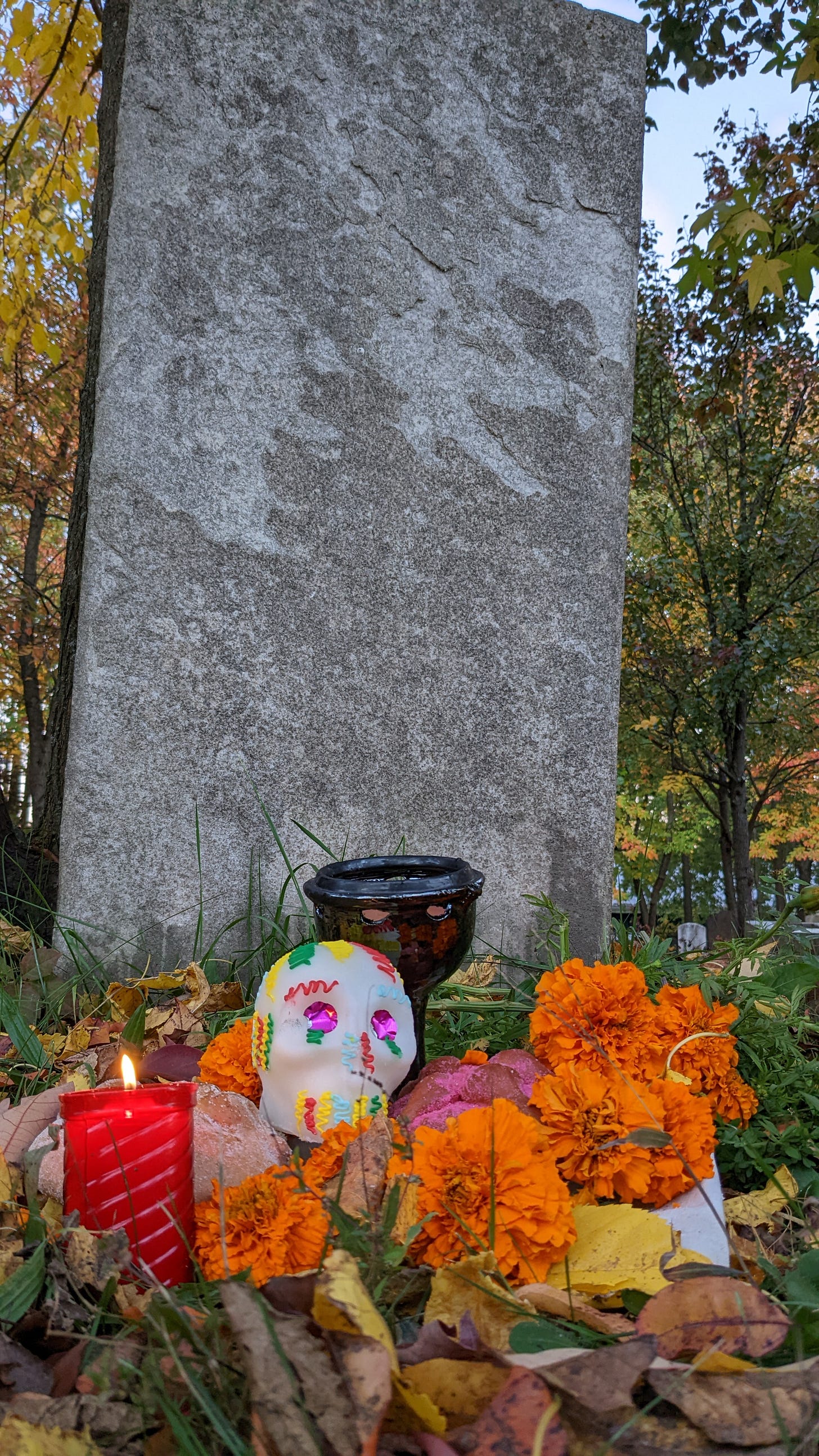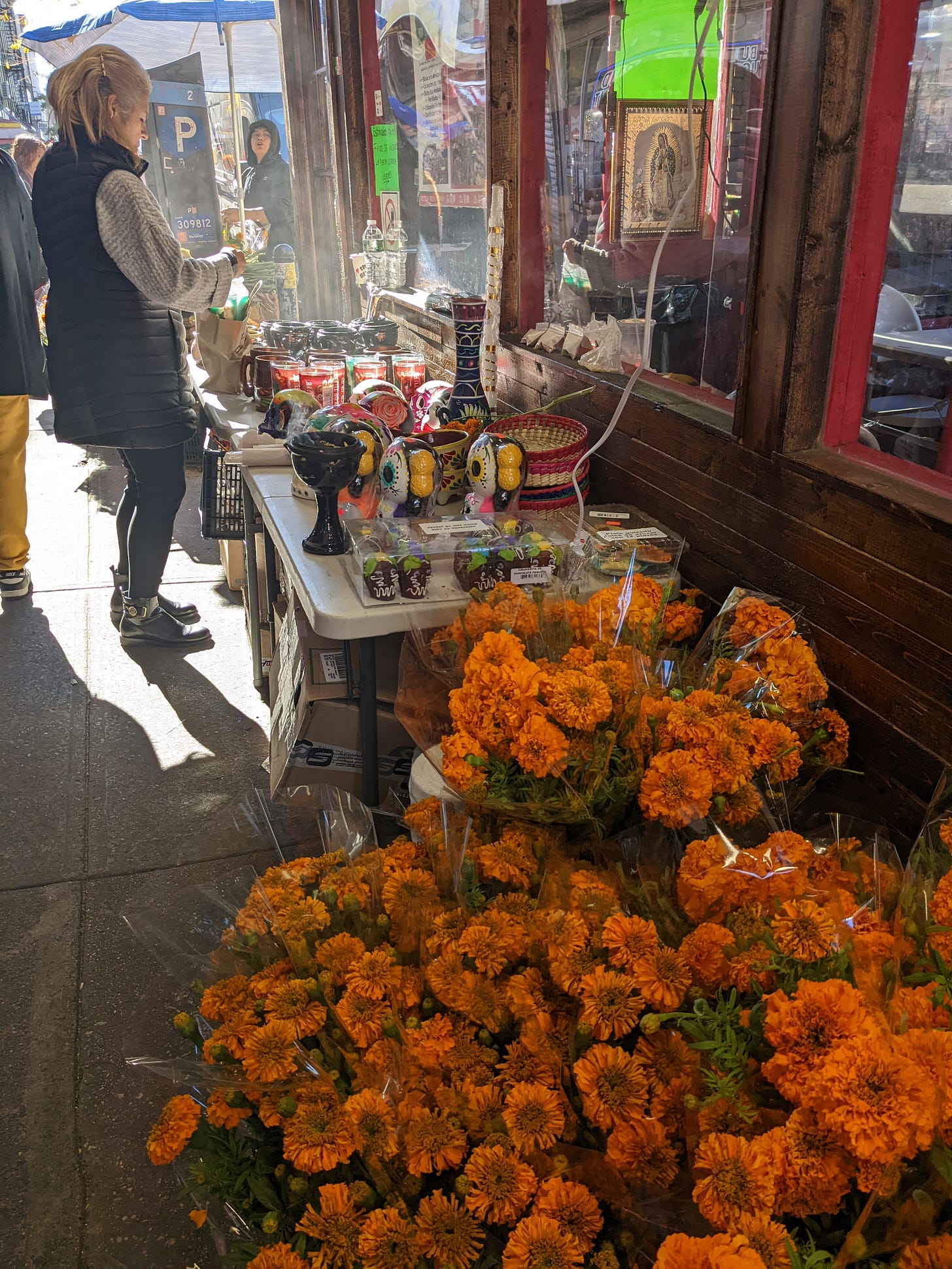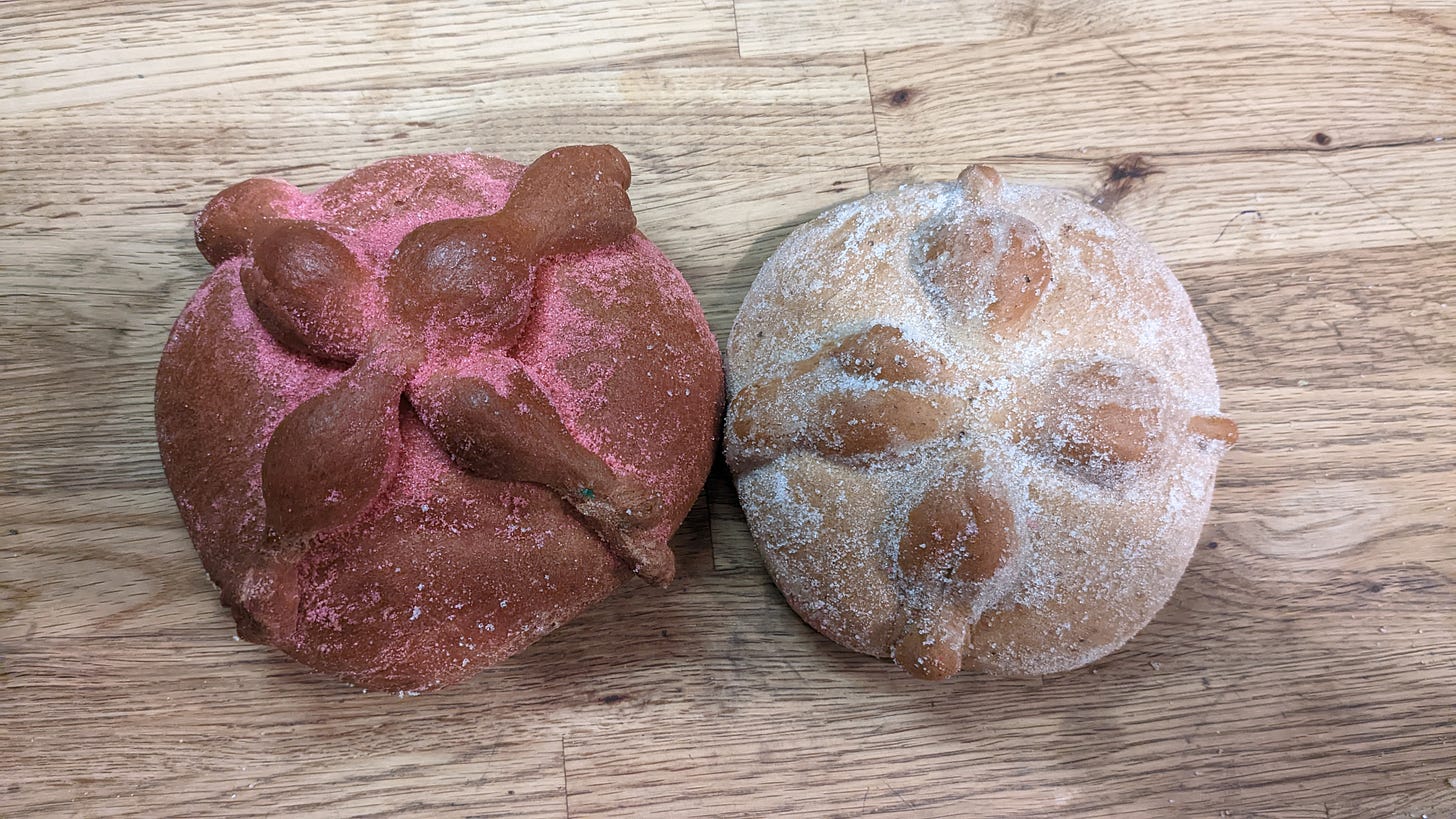Hello, Dear Departed!
How wonderful it is to spend a couple of days with you again surrounded by old traditions in a new land.
The whole weekend long, the street was crowded with bundles of long stemmed marigolds. Delicate, colorful tissue banners with cutouts of merry skeletons, strung high across the pavement from lampposts to store awnings, fluttered above hurrying passerbys. Tables set up along the curb offered for sale shiny black pottery chalices for burning incense, votive candles, and sugar and chocolate skulls with sequin eyes. Bakery windows showcased round sweet breads decorated on top with long skeleton fingers. You had to walk sideways down the sidewalks, around women carrying heavy shopping bags and children vying for treats. The autumn weather was kind on Saturday and Sunday, warm and sunny, inviting to be outside, to be caught up in the excitement of preparing for Día de Muertos, the Day of the Dead.
My family lived in this neighborhood a good twenty years ago, one of the best places I’ve ever settled in my life. When we moved in our neighbors were predominately Puerto Rican with a few whites left over from when they worked on the shipping docks down in the harbor. The neighborhood was boisterous and tight-knit and the whole community broke out together when it was time to celebrate The Three Kings, Mother’s Day, and New York City’s Puerto Rican Day. There were other holidays but these were the ones when it seemed the entire neighborhood erupted in flags and fireworks, a long line outside the best restaurants, and the parade of many many special dishes carried from one house to the next.
Mexicans began arriving in the neighborhood a dozen years after us. It wasn’t so much that they were unwelcomed as that the deep roots of the Puerto Ricans residents were wary of change. The most visible sign that the neighborhood was evolving was the sudden appearance of a smattering of tiny storefront restaurants serving moles, tamales, and tacos. A couple of bakeries filled with pan dulces slipped in between shops offering quesitos, tres leches, and guava filled pastries. The grocery stores and bodegas began to stock different spices, herbs, roots, vegetables, and meat cuts. Everyone spoke Spanish but not the same Spanish. Everyone was okay with one another except when they weren’t. It was the essence of a transitioning neighborhood.
That was the situation when, for family reasons, we reluctantly moved away. I’ve gone back frequently to hang out with friends. Everything seemed pretty much the same. But then came Saturday when I wandered over to the neighborhood searching for Scotch bonnet peppers and culantro for Puerto Rico’s national dish, Azzoz con Gandules, and found myself in the midst of the preparations for the Day of the Dead. I met one of my old neighbors stooping over a bucket full of marigolds. She picked out two bunches—one to place before a picture of her mother who passed away two years ago, and another because they were beautiful and would brighten her apartment.
“Look at these!” she said and urged me to pick out my own bouquets.
“I don’t remember it being like this,” I said.
“Oh, for years now,” she said. “Little Mexico right here.”
I was waiting to hear the old wariness in her voice but it wasn’t there. Time had gone by, a vibrant new tradition electrified the neighborhood and now seemingly treasured by the community.
“Get some flowers for yourself,” she said as a farewell.
I picked several bunches of my own. Then into a bakery for pan de muerto, one sparkling with cinnamon sugar, the other as pink as a birthday cake. From a table near where I had parked the car, I bought tissue banners of skeletons and a sugar skull. On Sunday I drove to an old abandoned church surrounded by a small graveyard filled with people who needed remembering.

The rest of the marigolds are in a little vase before a photograph of my mom and dad. They are dancing cheek to cheek, what I picture them doing on the other side.
For anyone who has never tasted it, pan de muerto is a sweet bread. Bites of it go well with strong coffee but then pan de muerto goes well with everything, and also a treat by itself. My preference is for the plain sugar version and, best of all, ones dusted with cinnamon sugar.
I was going to be all “I know what I’m doing,” for this story and show you that I can bake what is essentially a simple bread. That didn’t happen. So I found the most authentic recipe there is from the great Diana Kennedy.
Pan de Muerto From The Art Of Mexican Cooking by Diana Kennedy (Bantam Books, 1989)
Kennedy’s introduction to the recipe:
For the religious and agnostic alike, observance of All Saints and All Souls—the Days of the Dead as they are commonly called in Mexico—is one of the most important events of the year. People travel hundreds of miles to take flowers and food to the graves of their departed relatives but it is no morbid affair as they eat and celebrate together. In some homes an altar will be set up and decorated with yellow flowers, cempasuchi (Tageted erecta), candles, candied skulls and fruit, tamales, mole, chocolate, and pan de muerto. In and around the capital the breads are of varying sizes, round and decorated with stylized “bones” and a round topknot, representing the skull. In parts of Oaxaca the bread is formed into human shapes, and in Michoacán monos, small figures of animals or people are made.
Recipes for this bread vary tremendously depending on the financial situation of the family or the predicaments of the bakers. I have found no better than this one, given to me when I was apprenticed—rather informally—to one of the leading bakeries in Mexico City some years ago. The quantity will make one large one—about 11 inches in diameter, which is impressive—and about three small ones, which are always good as little presents or for hungry Halloweeners.
The oven temperature is given for a large bread, it should be increased to just about 400°F/200°C for the smaller ones.
The starter can be made ahead or the day before. (Any leftover can be frozen but is best used right away.) In fact, the final mixture can be kneaded and then left overnight in the refrigerator—which I do to help it develop a better flavor—and brought up to room temperature before forming an the final rising.
I am giving an exact translation from the metric weight, knowing that with bread dough a little variation here and there does not change the end product significantly.
THE STARTER:
1 pound (4 scant cups) unbleached flour, plus extra for bowl and working surface
1/2 ounce (1 1/4 teaspoons) sea salt
2 ounces (1/3 cup) sugar
Scant 1 ounce (3 scant tablespoons) crumbled cake yeast or 1 1/2 scant tablespoons dry yeast
1/2 cup plus 2 tablespoons water
3 large eggs, lightly beaten
THE FINAL DOUGH:
The Starter torn into small pieces
1/2 pound (1 cup) sugar
7 ounces (14 tablespoons) unsalted butter, softened, plus extra for greasing baking sheets
1 pound unbleached flour, plus extra for board and bowl
8 egg yolks, lightly beaten with 2 tablespoons water
1/4 cup water, approximately
1 teaspoon orange flower water and/or grated rind of 1 orange
THE GLAZE:
4 egg yolks, lightly beaten
1/4 cup melted unsalted butter, approximately
1/3 cup sugar, approximately
THE STARTER:
Put the flour, salt, sugar and yeast into a mixing bowl and gradually beat in the water and eggs. (Mexican bakers do not bother to cream the yeast, knowing that it is fresh - do it if you wish.) Continue beating until the dough forms a cohesive mass around the dough hook; it should be sticky, elastic and shiny - about 5 minutes. Turn out onto a floured board and form into a round cushion shape. Butter and flour a clean bowl. Place the dough in it and cover with greased plastic wrap and a towel and set aside in a warm place - ideally 70°F/21°C - until the dough doubles in volume, about 2 hours.
THE FINAL DOUGH:
Liberally grease 4 baking sheets (for both breads while proofing). Put the starter, sugar and butter into a mixing bowl and mix well, gradually beating in the flour and egg yolks alternately. Beat in the water and flavoring - you should have a slightly sticky, smooth, shiny dough that just holds its shape (since eggs, flours and climates differ, you may need to reduce or increase the liquid). Turn the dough out onto a lightly floured surface and form into a round cushion shape.
Wash out mixing bowl, butter and flour it, and replace the dough in it. Cover with greased plastic wrap and a towel and set aside in a warm place - ideally about 70°F/21°C - for about 1 1/2 hours, until it almost doubles in size, or set aside overnight in the bottom of the refrigerator.
Bring the dough up to room temperature before attempting to work with it. Turn out onto a lightly floured board and divide the dough into two equal pieces. Set one aside for forming later. Take three quarters of the dough and roll it into a smooth ball. Press it out to a circle about 8 inches in diameter - it should be about 1-inch thick. Press all around the edge to form a narrow ridge - like the brim of a hat - and transfer to one of the greased baking sheets. Cover loosely with greased plastic wrap and set aside in a warm place (about 70°F/21°C) to rise about half its size - about 1 hour. Taking the remaining one-quarter of the dough, divide it into four equal parts. Roll one of the parts into a smooth ball. Roll the other 3 strips about 8 inches long, forming knobs as you go for the "bones." Transfer the four pieces to another greased tray, cover loosely with greased plastic wrap, and set aside to rise for about 1 hour.
Repeat these steps to form the second bread with the other piece of dough that was set aside. Heat oven to 375°F/190°C.
At the end of the rising period, carefully place the strips of dough forming the "bones" across the main part of the bread, place the round ball in the middle to form the "skull," and press your finger in hard to form the eye sockets. Brush the surface of the dough well with the beaten yolks and bake at the top of the oven until well browned and springy - about 15 to 20 minutes. Turn off the oven, open the door, and let the bread sit there for about 5 minutes more. Remove from the oven, brush with melted butter, and sprinkle well with sugar.





